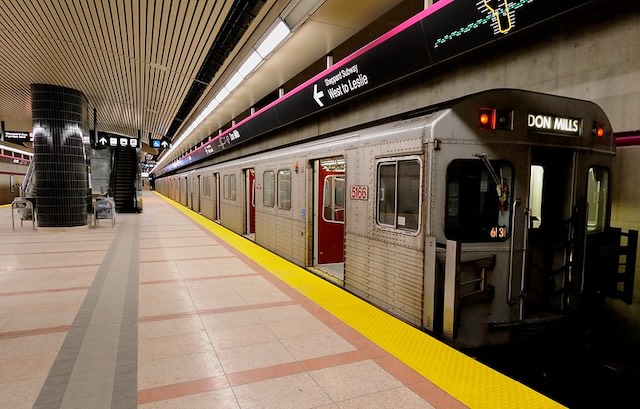The United States is not the only country where transit agencies are wildly spending on questionable projects that suffer huge cost overruns. In Canada, Toronto opened its first subway in 1954 at a cost of just $11 million per mile — $90 million per mile in today‘s U.S. dollars. The city is currently building a subway line that was supposed to cost almost US$1.0 billion a mile, but with cost overruns is expected to cost as much as US$1.4 billion a mile.
Toronto subway. Photo by Tim Adams.
Light rail in Canada has also undergone huge price inflation. Edmonton opened North America’s first modern light-rail line in 1978 at a cost of US$47 million a mile in today’s money. Today, Calgary, Hamilton, Kitchener, and Toronto are all planning or building light-rail lines that are expected to cost at least US$300 million a mile, and several of these have had cost overruns of as much as 180 percent.
Then there’s Vancouver’s SkyTrain, which is a medium-capacity transit system, meaning it can move more people per hour than light rail but not as many as heavy rail (though one SkyTrain line can’t even move as many people per hour as light rail). Vancouver’s first SkyTrain line cost about US$48 million a mile in today’s dollars. The city is now building one that will cost about US$600 million a mile and planning another, much longer line that was first projected to cost US$225 million a mile but is now projected to cost at least US$300 million a mile.
The willingness to spend so much money on projects that were questionable even at their original low costs and the frequency of huge cost overruns are both examples of optimism bias, the tendency to overestimate positive outcomes and underestimate negative ones. A study released last week found that such optimism bias is associated with a lack of intelligence.
As the report puts it, “optimism bias is partly a consequence of low cognition — as measured by a broad range of cognitive skills, including memory, verbal fluency, fluid reasoning and numerical reasoning.” Based on a survey of thousands of people, the study found that those who have higher cognitive skills are much more likely to be realistic (which others would consider pessimistic) about the future and much less likely to suffer from optimism bias.
The author of the study, Chris Dawson, is an associate professor of management at the University of Bath. He has written numerous papers on how cognitive skills influence decision making, including one that found that U.K. residents who voted against leaving the European Union had higher cognitive skills than those who voted to exit. Still, his most recent paper attributes a quote to Ayn Rand (who would have supported Brexit), who supposedly said (but probably didn’t), “You can avoid reality, but you cannot avoid the consequences of avoiding reality.”
So does this mean that the planners who plan these projects lack cognitive skills? Maybe; maybe not. Unfortunately, transit planners have discovered they can avoid the consequences of avoiding reality. Thanks to the iron triangle — bureaucrats, politicians, and special interest groups — agencies are rewarded with bigger budgets when they plan super-expensive projects and are almost never penalized for cost overruns. The only ones who can’t avoid the consequences of avoiding reality are the taxpayers.









For far too long PLANNERs have used people. NAMELY poor or working class people as guinea pigs for grandiose public social experiments.
Urban planners gave us
– urban freeways
– high rise public housing projects
– Section 8
– bizarre architecture experiments in affordable housing.
– Jane Jacob’s Bible
– SRO planning
– slum clearance
– and the Super block.
In any case, transit and urban planning is ever declining profession. Transits relevance to urban economics is less important because urban areas are becoming less relevant to economy.
– The US has a super efficient freight rail system that can move trillions tons goods/commodities at extremely low labor cost. This puts us economic advantage in warehousing and goods distribution over EU and Asia. Bar codes and the international shipping container means we don’t have to open them to move its specific contents.
– US has 15,000 Airports or runways, air distribution of packages and freight is ubiquitous on global level.
– Urban land prices, have made industries like steel making, car production and machine part fabrication insoluable, at this point, electric power has replaced coal/coke so American industry doesn’t really pollute much anymore, and is also quieter, so factories/industry in suburbs are not only tolerable, but transportation makes them convenient.
– historic seaports have too shallow a draft to accommodate the supermassive container vessels
– Energy in USA is cheaper than Europe and Japan, which benefits Energy intensive industries like metal processing, concrete making. BMW’ largest factory…..is in South Carolina.
– Lastly, thing most people forget, USA has more entrepreneurs and self employed people than EU and Japan. They require on demand transportation, that only cars fulfill.